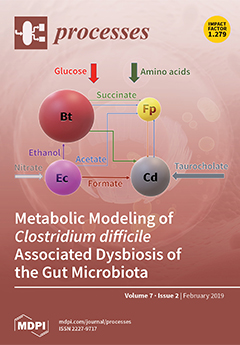Recent in vitro experiments have demonstrated the ability of the pathogen
Clostridium difficile and commensal gut bacteria to form biofilms on surfaces, and biofilm development in vivo is likely. Various studies have reported that 3%–15% of healthy adults are asymptomatically colonized with
C. difficile, with commensal species providing resistance against
C. difficile pathogenic colonization.
C. difficile infection (CDI) is observed at a higher rate in immunocompromised patients previously treated with broad spectrum antibiotics that disrupt the commensal microbiota and reduce competition for available nutrients, resulting in imbalance among commensal species and dysbiosis conducive to
C. difficile propagation. To investigate the metabolic interactions of
C. difficile with commensal species from the three dominant phyla in the human gut, we developed a multispecies biofilm model by combining genome-scale metabolic reconstructions of
C. difficile,
Bacteroides thetaiotaomicron from the phylum Bacteroidetes,
Faecalibacterium prausnitzii from the phylum Firmicutes, and
Escherichia coli from the phylum Proteobacteria. The biofilm model was used to identify gut nutrient conditions that resulted in
C. difficile-associated dysbiosis characterized by large increases in
C. difficile and
E. coli abundances and large decreases in
F. prausnitzii abundance. We tuned the model to produce species abundances and short-chain fatty acid levels consistent with available data for healthy individuals. The model predicted that experimentally-observed host-microbiota perturbations resulting in decreased carbohydrate/increased amino acid levels and/or increased primary bile acid levels would induce large increases in
C. difficile abundance and decreases in
F. prausnitzii abundance. By adding the experimentally-observed perturbation of increased host nitrate secretion, the model also was able to predict increased
E. coli abundance associated with
C. difficile dysbiosis. In addition to rationalizing known connections between nutrient levels and disease progression, the model generated hypotheses for future testing and has the capability to support the development of new treatment strategies for
C. difficile gut infections.
Full article





